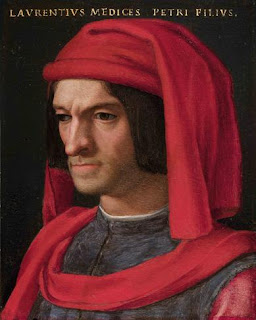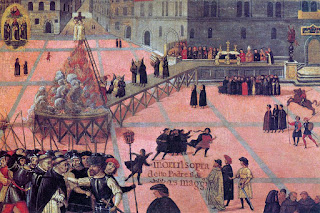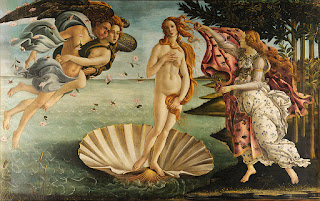Art enthusiast who was Botticelli’s major patron
 |
| Botticelli's 1479 Portrait of a Young Man, is thought to be Lorenzo di Pierfrancesco |
The great-grandson of Giovanni di Bicci de’ Medici, the founder of the Medici bank, Lorenzo di Pierfrancesco belonged to the junior, sometimes known as ‘Popolani’ branch of the House of Medici.
In 1476, when he and his brother, Giovanni, were still boys, their father, Pierfrancesco de’ Medici the Elder, died. They became wards, effectively, of their cousin, Lorenzo il Magnifico - Lorenzo the Magnificent - a member of the senior branch of the family and the effective ruler of Florence.
Relations between the two branches had been tense for some years and were not helped when Lorenzo di Pierfrancesco discovered, on becoming an adult, that Lorenzo had plundered a considerable sum from he and his brother’s joint inheritance in order to stave off a threatened bankruptcy of the family’s financial empire.
Although Lorenzo had provided the boys with the best education money could buy - the notable Florentine Renaissance humanists Marsilio Ficino, Angelo Poliziano and Giorgio Antonio Vespucci (uncle of Amerigo) were among their tutors - and given them a number of properties in compensation, the incident created a lingering bitterness.
Meanwhile, thanks to the curiosities stirred by the education he received, Lorenzo di Pierfrancesco developed a reputation as an art connoisseur. In around 1485, he commissioned an illuminated manuscript of Dante's Divine Comedy featuring artwork by Botticelli, to whom he had been introduced by the Vespucci family, who were neighbours of the Botticellis in Florence.
 |
| Botticelli's Primavera is thought to have been commissioned to celebrate Lorenzo di Pierfrancesco's marriage |
It is thought that Lorenzo il Magnifico commissioned Botticelli's Pallas Athene Taming a Centaur as a wedding gift to the new couple, while either Lorenzo il Magnifico or Lorenzo di Pierfrancesco himself had Botticelli paint his allegorical work Primavera as a celebration, with Mercury representing Lorenzo di Pierfrancesco and Semiramide by the central figure of Grace.
After the wedding, both paintings were displayed on the walls of Lorenzo di Pierfrancesco’s villa in the centre of Florence. Some accounts suggest that he also commissioned Botticelli's best known work, The Birth of Venus, one of the most famous paintings of the Renaissance by any artist.
The tension that still existed between him and Lorenzo il Magnifico came to a head in October 1484, when his cousin, determined to protect the primacy of the senior branch of the Medici family, had Lorenzo di Pierfrancesco's name removed from the lists of persons eligible for election to the Florentine political institutions.
 |
| Angelo Bronzino's portrait of the Florentine leader Lorenzo il Magnifico |
When Lorenzo il Magnifico died in 1492, Lorenzo and Giovanni sided against il Magnifico's son, Piero. They were exiled as a result but returned when King Charles VIII of France invaded Italy and Piero was ousted from Florence by a Republican government.
The nickname Popolano - meaning ‘of the people’ - was coined for the brothers and Lorenzo di Pierfrancesco became a popular figure in the new administration. He extended his patronage of the arts to protect Botticelli, Michelangelo, Filippino Lippi and Bartolomeo Scala, and in 1494 he founded a workshop of ceramics at Cafaggiolo.
He was pushed out when the hellfire preacher Girolamo Savonarola swept to power in 1494 with his denunciation of clerical corruption, despotic rule and the exploitation of the poor, yet refused to return even after the controversial Dominican friar was burned at the stake in the main square of the city in 1498.
Lorenzo di Pierfrancesco died in Florence in 1503, aged only 39. Years later, his grandson Lorenzino de' Medici murdered Alessandro de' Medici, the last ruler of Florence from the senior branch of the Medici, thereby passing power to Lorenzo's great-grandson Cosimo I de' Medici.
 |
| The Villa del Trebbio, which Cosimo de' Medici turned into a fortified castle |
One of the properties owned by Lorenzo di Pierfrancesco was the Villa del Trebbio, which he inherited from his grandfather Lorenzo the Elder. Located near San Piero a Sieve in the Mugello region, the area from which the Medici family originated, it was possibly the first of the Medici villas built outside Florence, on top of a hill dominating the Val di Sieve. It had earlier belonged to Giovanni di Bicci de' Medici, the founder of the Medici bank, and was remodelled by his son, Cosimo de' Medici, whose architect, Michelozzo, restyled it as a fortified castle.
 |
| The Piazzale between the two wings of the Uffizi, which links Piazza della Signoria with the Arno river |
Primavera, Pallas Athene Taming a Centaur and The Birth of Venus are among a number of Botticelli paintings displayed in the Uffizi Gallery in Florence, which is one of the largest and best known art museums in the world. Its collection of priceless works, particularly from the period of the Italian Renaissance, owes much to Anna Maria Luisa de' Medici, the last Medici heiress, who bequeathed the family’s entire art collection to the city of Florence. The Uffizi was open to visitors by request as early as the 16th century, and in 1765 it was officially opened to the public.
More reading:
Why Lorenzo the Magnificent was seen as a benign despot
Cosimo de' Medici - the first Medici ruler of Florence
How Sandro Botticelli's paintings became forgotten works of genius
Also on this day:
1521: The birth of Pope Urban VII
1994: The death of politician Giovanni Spadolini
Home












